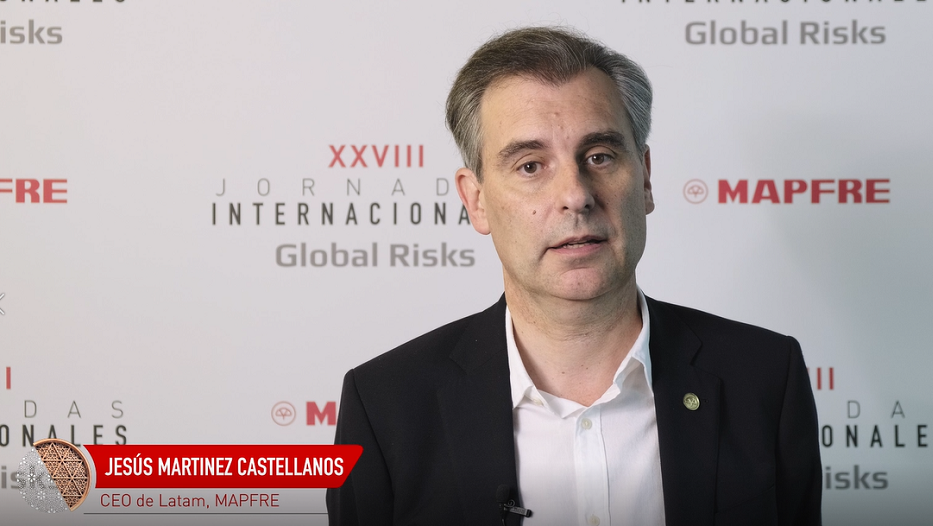The most notable behavior of Insurance during the pandemic, the need to transform business models, coverage gaps and deficits, where public-private collaboration could help, the power of the customer in companies and the threat of cyber risks. These were some of the issues that surfaced during the discussion at the ‘Insurance Market Insights’ roundtable, held within the framework of the MAPFRE Global Risks International Seminars.
The meeting was moderated by José Manuel Inchausti, the Third Vice President of MAPFRE and CEO of MAPFRE IBERIA. The following participated as speakers: Pilar González de Frutos, President of UNESPA; José Antonio Sánchez Herrero, Managing Director of ICEA; and Ricardo González García, Director of Sectoral Studies Analysis and Regulation at MAPFRE Economics.
Commitment to sustainability, the disruptive changes that the pandemic has brought with it, both economic and sociocultural, the invasion of Ukraine by Russia and, consequently, the exacerbation of inflation phenomena and the breakdown of supply chains, and to that we must add the growing risks of cyberattacks, among other elements, all paint a picture “in which the position of risk manager, which has never really been easy, has become even more complex,” José Manuel Inchausti began by saying.
More than just a remarkable performance
The pandemic has had a marked impact on the road map during the 2020 and 2021 fiscal years, and the insurance industry has taken the lead. For Pilar González de Frutos, “its behavior as an industry during this episode has been more than remarkable” and she raised as examples the work of Insurance as a home service provider, at a time when it was subject to greater than usual use, and the adaptation of health insurance, which took this opportunity to undertake accelerated development in telemedicine.
Another sample of its more social aspect was the decision not to deny assistance and coverage to many insured parties, despite the exclusion of coverage, a commitment that began with the health sector and continued insured party the case of life and death insurance, among others. For Pilar González de Frutos, “we must continue to make citizens aware of what that meant, because we did not have enough information available to guarantee what the risks we were taking with those decisions actually were.” She also upheld the commitment to do everything possible so that the insurance service provision network, the most important in our country, would be maintained. “Each entity, to the extent of its business model, implemented actions to help suppliers: from billing in advance to financial aid.”
Furthermore, the sector showed its social commitment by launching a fund of €38 million during the pandemic, financed by 107 insurance companies, to provide coverage in the event of death or hospitalization for staff working in public or private healthcare and in residences. for the elderly or disabled. The surplus is now contributing to COVID-19 research and helping vulnerable groups.
Transforming the industry in the face of challenges
The insurance industry is going in the right direction, said José Antonio Sánchez Herrero. “Taking a look at these past two years, and if we compare 2021 against the year before the pandemic, we have been able to maintain the sector’s vital signs, both from a profitability and, most importantly, a solvency standpoint.” This demonstrates its ability to manage itself, and overcome numerous crises over the years.
In his view, the pandemic has strengthened the window of opportunity for the sector’s future. “People have realized how important it is to have insurance and I have no doubt about the growing potential for insurance demand, because we are generally heading towards a society with a higher level of uncertainty, of greater inequality, so the appetite for being insured will grow.”
José Antonio Sánchez adds, “we are an industry that has not yet suffered a severe disruptive process, as has happened in other areas, and we will have time to settle down”, furthermore expressing his commitment to transforming organizations in order to capitalize on opportunities arising. “We are moving towards a new reality, a new competitive scenario to which we will have to adapt so that the business model we have in place, that has brought us to where we are now, can continue to take us forward over time in a positive manner.”
The power of the customer and the engagement of talent
The customer’s impact on the insurance industry, like any other, is very significant. For José Antonio, “the power that companies once had has shifted to the customer.” But on top of that, the pandemic has led to a radical change in behavior and is increasingly digital. “It’s true that in the insurance industry this process has been slower, but it will get there.”
Additionally, he drew attention to new competitors who are going to result in the competitive advantage, which has been traditionally based on having a product to offer, shifting to data-based information and an intimate knowledge of the customer. In short, “we must adopt a customer-oriented strategy and offer them a unique experience”. This also assumes that, “over and above purely insurance coverage, we will have to build a series of services that in many cases will even include companies that are not from our industry. So we also have to change the way we think a little bit and move towards a strategy of collaboration.”
Regarding the engagement of talent, José Antonio Sánchez expounded the view of “selling us better, because we have a great reality in our industry, but sometimes the perception of us is not altogether fair.” In addition, in the new competitive environment “what we need are different organizational cultures that are much more agile. Those who succeed will be the ones who are able to best adapt.” He added, “we have to try to introduce a certain culture of innovation and change our leadership style. The new generations are looking for projects and organizations that make sense of their lives and we have a lot to do in this regard, in our industry.”
Reaction by companies
But how are companies reacting to risk in the current situation? In principle, for Ricardo González, “both large and small companies always tend to protect their margins. They don’t want surprises in their income statements. So, the idea is to manage these risks internally, if they can, because they have sufficient capacity and the means to do so; and if they cannot, looking for additional external coverage, if there is any to be had, at a reasonable price.”
With everything that is happening, MAPFRE Economics is seeing an increase in the demand for coverage by companies and also a tightening in the market. “For example, in the first five months of this year, compared to the pre-pandemic premium level in 2019, industrial risks have increased by 25.3% and third party liability by 16.5%. That is to say, all of this has greatly stimulated companies’ search for coverage.”
Public-private collaboration
Not only are new threats emerging. The risks already known about, in many cases, are increasing in terms of frequency and damage intensity. And all of this, according to Pilar González de Frutos, “is creating real coverage challenges and gaps in coverage occurring in many jurisdictions.”
Public-private collaboration is effective in working through these coverage gaps. In fact, Spain has two systems in this area that, according to González de Frutos, “work and help us a great deal to stabilize the market, so as to be able to grant protection.” This is the role of the Insurance Compensation Consortium in the event of disasters, as well as the coverage model for agricultural insurance.
The president of UNESPA also insisted that “it is the right time to analyze whether these solutions and in particular Consortium coverage, can evolve in view of the frequency and intensity of the phenomena arising from climate change.” In addition, he acknowledged that “in the case of new risks, such as cyber, we can grant certain types of coverage, but not full coverage, as we don’t even know at this time how far this could reach and indeed it would not be possible without such public and private participation.”
Cyber risk, the main concern
Right now, this threat has become the number one concern for risk managers. According to the data they manage at MAPFRE Economics, worldwide the insurance premiums that cover these risks could be around $100 billion, a figure that seems enormous, but which, compared to the $6.4 trillion for the global billing value, represents only around 1.5%. “In other words, there is a coverage gap, a very large coverage gap,” said Ricardo González.
Among the challenges for the insurance industry, he highlighted the level of sophistication that hackers have reached, the increase in frequency and, above all, the lack of sufficient data to calculate good pricing and build robust models that attempt to model the most severe attacks.
On sustainability regulation
Another concern is about sustainability regulation. In the opinion of Pilar González de Frutos, “if there is a sector where sustainability makes sense, it is in the insurance industry, because it is part of our DNA. Every time a new risk arises, it tests the capabilities in place of managing prevention measures with the importance that this has not only in preventing damage, but also in terms of general awareness among the population.”
At the European level, regulatory sustainability initiatives are great in number. “At this time, we are faced with a veritable deluge of obligations, such as disclosure requirements, to which we have to comply and we are doing so without having a set of concrete rules in place for us to be certain whether what we are doing is exactly what we should be, or what is being asked of us,” he concluded.





